This space aims to investigate and raise awareness of the changes, events and transformations we as a species appear to exert upon our planets climate. What responsible actions can we, our governments, politicians, legislators, scientists, industrialists, engineers, miners, communicators, educators, schools, land managers, farmers, recyclers and neighbours do to practically assist in slowing and re-balancing the trends of climate change and global warming.
My aim is to provide a channel of communication concerning Local as well as International Forums, Key Meetings, Conferences, Organisations, links & networks to share the views, concerns and recommendations of climate, meteorlogical and energy scientists and yourselves.
I was born in the UK and have developed a career around the MoD, Healthcare, Theatre, Aerospace, Broadcast Television, Education, Assistive Technology & Information Technology. I have qualifications in Engineering, the Arts, Communications, Management and Business Systems.
In my early 20's I spent some time on a croft in the Outer Hebrides, off the west coast of Scotland. Planting crops and looking after a small herd of milking goats.
As it is for all people living off the land. You pay serious attention to the weather especially when the landscape is relatively low lying and you can see where those large water bearing clouds are heading. You begin to fathom its potential effect on carefully planted crops or drying peats, your staple ingredients and fuel for cooking and heating. These close observations also assisted in timing exits from shelter to avoid or enjoy downpours of rain.
It was here, where I had my first encounter with the truly awesome power of the oceans, during a trip with my friend Tom to his remote workplace high up on the cliffs on the west of the island.
The weather had deteriorated as the afternoon and evening progressed, a steady increase in wind and torrential rain. Later, I felt an unusual rumbling vibration. I asked my friend about it's cause. He said 'If you want to put your wet weather gear on I'll show you'. So, we kitted up and came out of the building into the night and nearly horizontal wind driven rain, and my friend gestured for me to drop down on all fours to the ground, he pointed to the cliffs edge some 40 metres away and we continued mostly crawling towards the cliffs edge, it being hard to look directly ahead because of the stinging force of the wind, rain and spray. After 5 mins we arrived at the edge of the 35 or 40 metre cliffs and there below us were awesome 25 metre Atlantic waves breaking against the tough gneiss rocks of the cliff. The noise was deafening and the vibration was now apparent and deeply felt. Lying, with our hands sheltering our faces and eyes, we watched for another 5 mins before crawling, staggering and soaked back to the building.
Having an interest in geography and maps, I was also fortunate to come across the literally 'ground-breaking' book 'Restless Earth' by Nigel Calder. This contained extraordinary photographs, satellite imagery, maps and diagrams. I loved it and many conversations with friends touched upon the topics of mid-oceanic ridges, volcanoes, plate tectonics, earthquakes, 'Ring of Fire', 'San Andreas fault', etc. As earths' history and potential future began to be revealed.
On my return to London, I began to note that winters were not as severe, as in my childhood, sometimes no snow at all now fell in the winter months. My early memories of walking to school in the late 1950's, in snow through thick coal-fire induced fogs. referred to by my mother as 'Pea-Soupers' with my arms outstretched to avoid bumping into lamp posts were not so frequent. People had begun to use gas or electrical rather than coal fires.
In 1991, I read the seminal and observant 'End of Nature' by Bill McKibben. Some months later, on a sunny Sunday afternoon, I had arranged to meet with friends to go kite-flying in Brockwell Park, To reach the park, I was attempting to cross London's - South Circular ring-road at a stand-still with traffic. The thick haze from the exhaust pipes from so many vehicles, caused me to cough and then catch my breath, then struggle to breathe. After hurrying across the road, away from the traffic. I fortunately recovered the ability to breathe, though later that day, I resolved to move out of London, and circumstances led to me to rural Salisbury in Wiltshire later in 1992. Here the air was cleaner, although winter snow only appeared briefly for a couple of winters over the next 9 years.
Having first travelled to Perth in 1994 and on returning to Australia in 2001 to live. I was aware that Australia was likely to be the first, to fully demonstrate the reality and effects of Global Warming to the world.
Now, I continue to monitor the news of extreme bush-fires, draught, floods, cyclones, earthquakes, discuss oceanic dipoles and El Nino effects and conditions. Not least simply observing the climatic effects on my garden, local Koondoola bushland and the agricultural area for several hundred kilometres north, south and inland from Perth.
often via: Bureau of Meteorology (BOM) and key International conferences on climate management e.g. COP25 and aim here, to provide practical links and to develop forums to extend communication on these critical areas.My personal view is that our orbiting solar system, containing the rarity of life giving earth, oceans and atmosphere in our galaxy has cycles and orbits which are not yet thoroughly perceived, researched and understood.
Through time, our planet has shown great changes of climate, with warming, and notably with ice ages causing the extinction of previous species including earlier generations of mankind.
I know that previous tectonic activity created the Alps the Himalayas, Rockies, Urals, etc. Also, that comparable mountains and a greater number of active volcanoes exist beneath our currently warming oceans. see: VOLCANOES & EARTHQUAKES - INTERACTIVE MAP The immense solar and galactic energies and cycles acting upon our earths core are likely a far larger factor towards climate change than the anthropogenic ones we are aiming to limit. Even considering the last 300 years of our wars, exploitation, industrial waste and emissions.
So, what can be done? I would advocate, from observing, the historical precedent(s) the futility of wars, motivated by a greed for power, and control of territory and resources. That these have repeatedly only led to death, destruction, poverty, famine, disease, mass migrations and modern slavery.
Logically then, we should instigate a humane re-distribution of wealth, primarily, the worldwide curtailment of arms and military spending and moving this to resource the humanitarian need for adequate food, clean water and housing worldwide. Together with massive funding and resources for further scientific earth and galactic research, and humane creative innovation. Our re-assigned armies, militias and populations can then focus their valuable energies on the removal of pollution, effective re-cycling of human generated waste, in conjunction with the construction of the energy, logistics, agriculture, infrastructure, education, health and communication systems for a truly self-sufficient and sustainable planet with the core aims being to extend our knowledge, protect our planet and future generations moving forward... Then we can truly begin to move forward and explore our universe and its and our own human potential.
Energy Options
This section aims to investigate the many sources of energy mankind has developed and considers these resources and options for urgent future review, investment and development. These are considered most relevantly in relation to climate change and worldwide agreements around carbon neutral policies as our technology and materials advance and we continue to search for sustainable and efficient solutions.
My aim is to promote your further inquiry and discussions concerning Local as well as International Industries, Forums, Key Meetings, Conferences, Organisations, links & networks To share the views, concerns and recommendations of climate & meteorlogical scientists, energy producers and yourselves as life-members of planet earth.
I was fortunate, I feel to be born, in a culture to have benefited from so much experimentation, innovation and industry especially from the ancient Chinese who began coal mining around 5000 years ago and later began smelting metal, developing ceramics and investigating the gas and oils resources they found underground.
The growth of coal and other fossil fuels extraction eventually, led thousands of years later, (most notably within the last 250 years) as these activities extended across Europe the Americas, Africa and the rest of Asia through various industrial revolution(s) and economic migrations, and has increasingly exploited these resources for the production of tools for agriculture, industry, transport and weapons - defence.
Worldwide these industrial activities eventually led to deforestation as agricultural development was also required to feed growing populations and more land was required to perpetuate industrial activity and the ongoing need for electricity and its allied coal, oil and gas supplies.
As you may expect China is still the largest, coal producing nation. See table below:
It also has the largest population to feed and support with energy for industrial, agricultural, defence and domestic needs
source: 10 Highest Populations [ 2019 Data ]

source: World Atlas
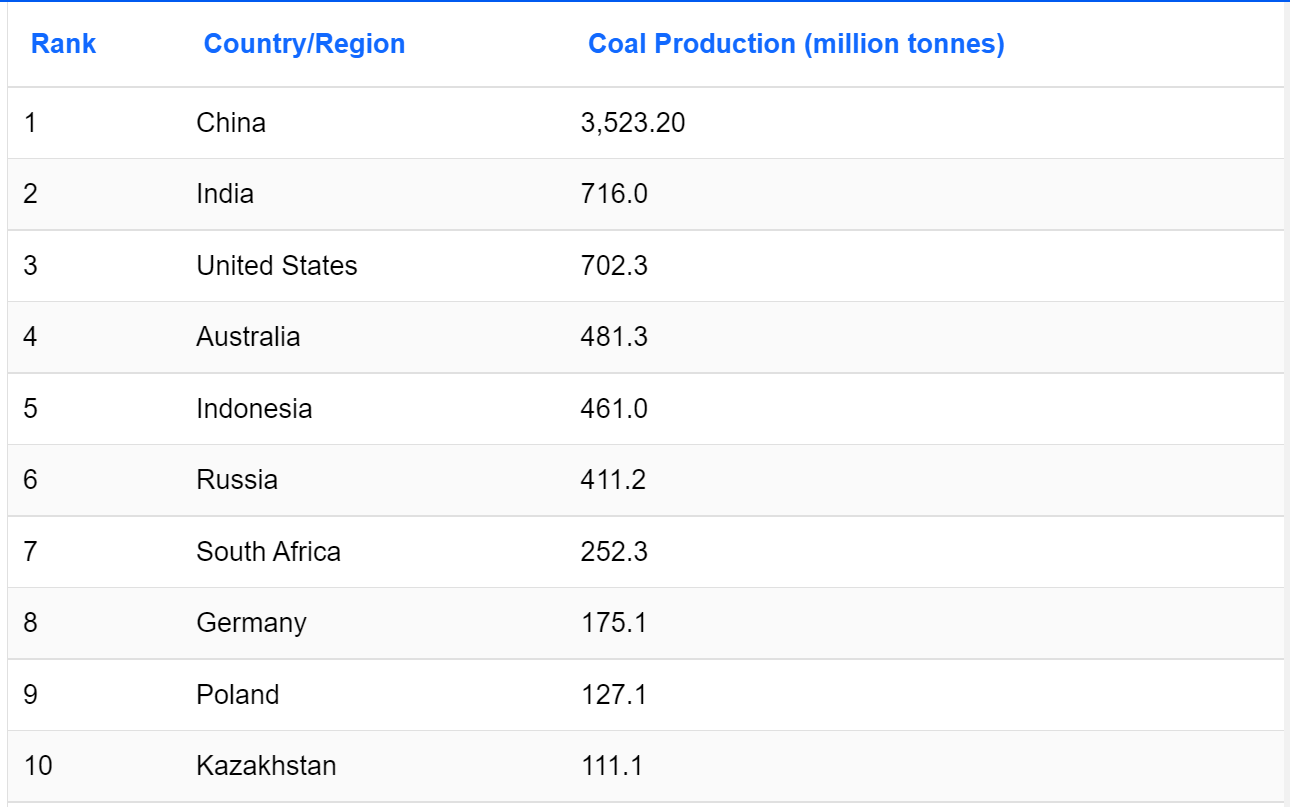
In 2019 Australia's energy consumption used the fossil fuels of Coal, Oil & Gas for 91.43% of its energy consumption. This is only a 3% reduction from 1965. Coal is used for 60% of electrical energy production in Australia.
source: Our World in Data - Australia - Energy Consumption by Source
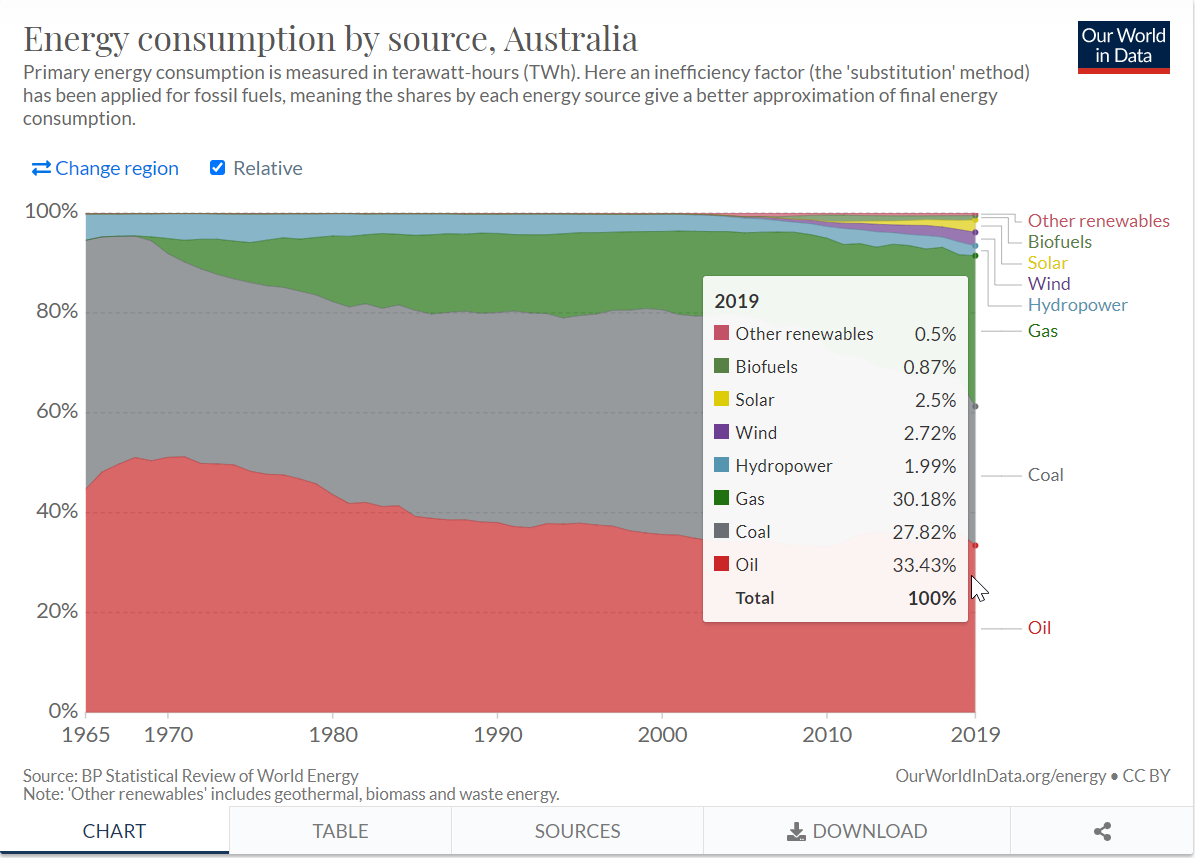
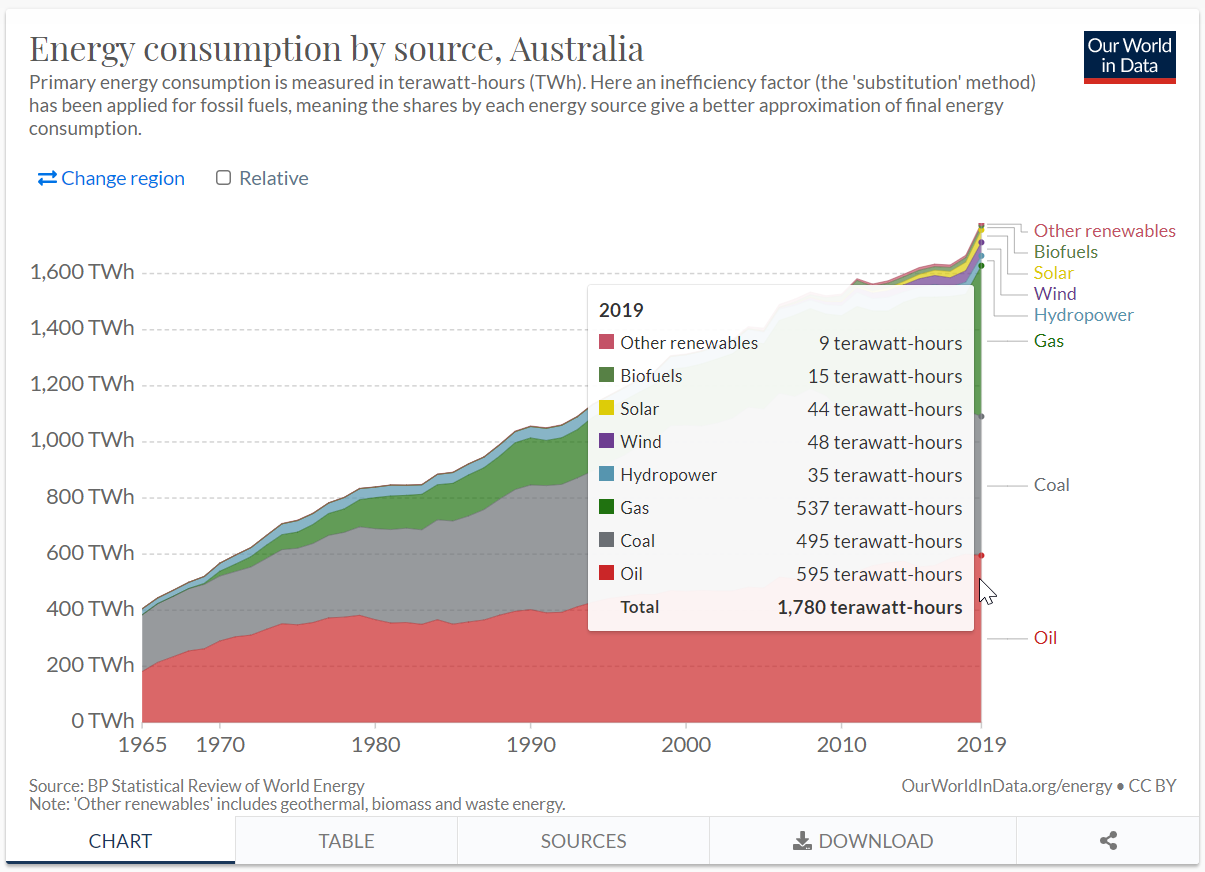
In comparison China being the worlds dominant consumer of fossil fuels, notably Coal, has managed since 1965 to reduce its energy consumption from 95.99% to 85.14% in 2019 by increasing its use of hydro-electric, nuclear power, wind and solar to show an 11% reduction from 1965 levels.
Renewables & Recycling
The key issues with some renewable energy technologies, concerns the inclusion of mineral and rare earth elements which are a finite resource on our planet. At this stage, these are not constructed from renewable or recyclable resources and materials and often have a limited e.g. 15 or 20 year lifespan. Notably, the physical elements of e.g. Solar Panels, Wind Turbines and Batteries are also, not being adequately recycled to reclaim these minerals and rare earths.In addition, there are several countries in Africa, etc. that are being exploited, including the use of child labour, in dangerous conditions, for the mining and processing of valuable substances, e.g. Lithium, that is used in Batteries for electric vehicles and solar storage.Recycling, is perhaps another topic, but it effects so many other products which we purchase and then indiscriminately throw away into landfill. My view, is that no producer or manufacturer of goods, should be permitted to sell their products and packaging, until they can prove (to a standard) that their recycling processes are effective in the reclamation of materials that can be reused.
source: Our World in Data - China - Energy Consumption by Source
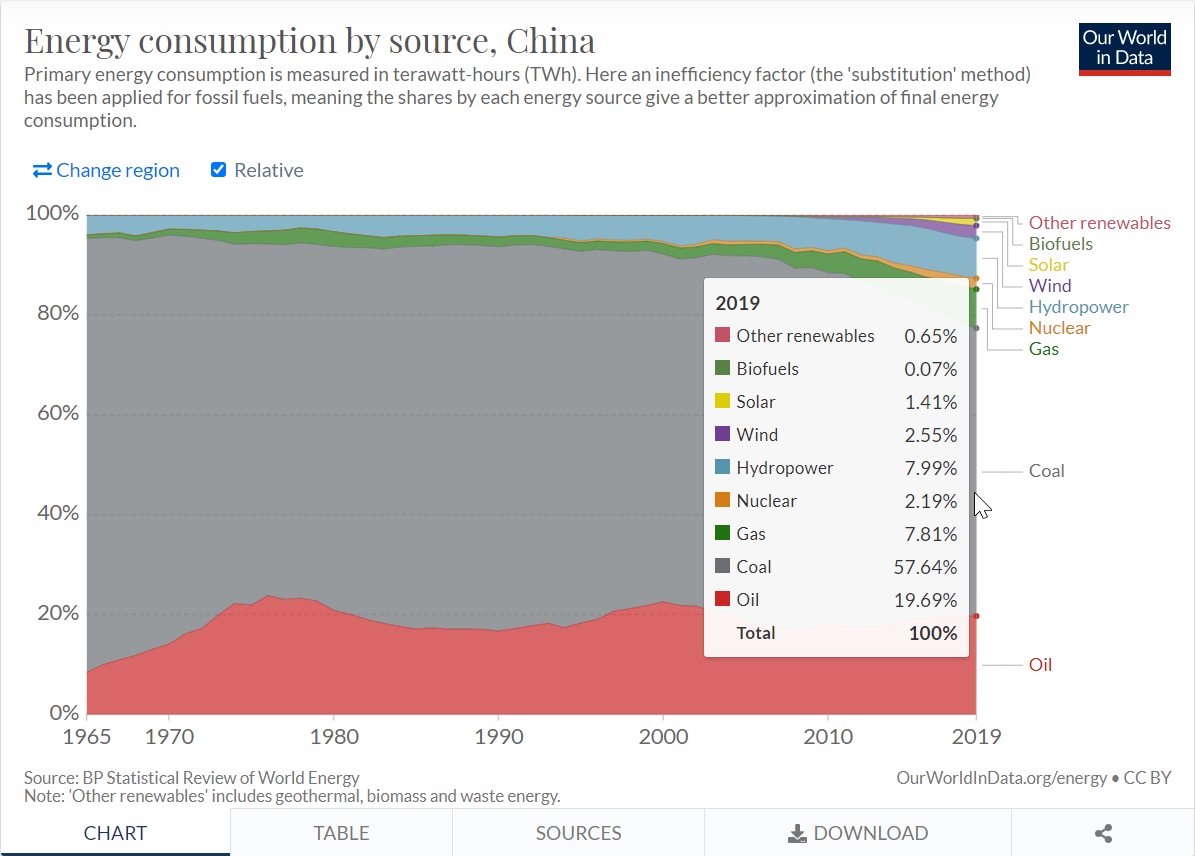
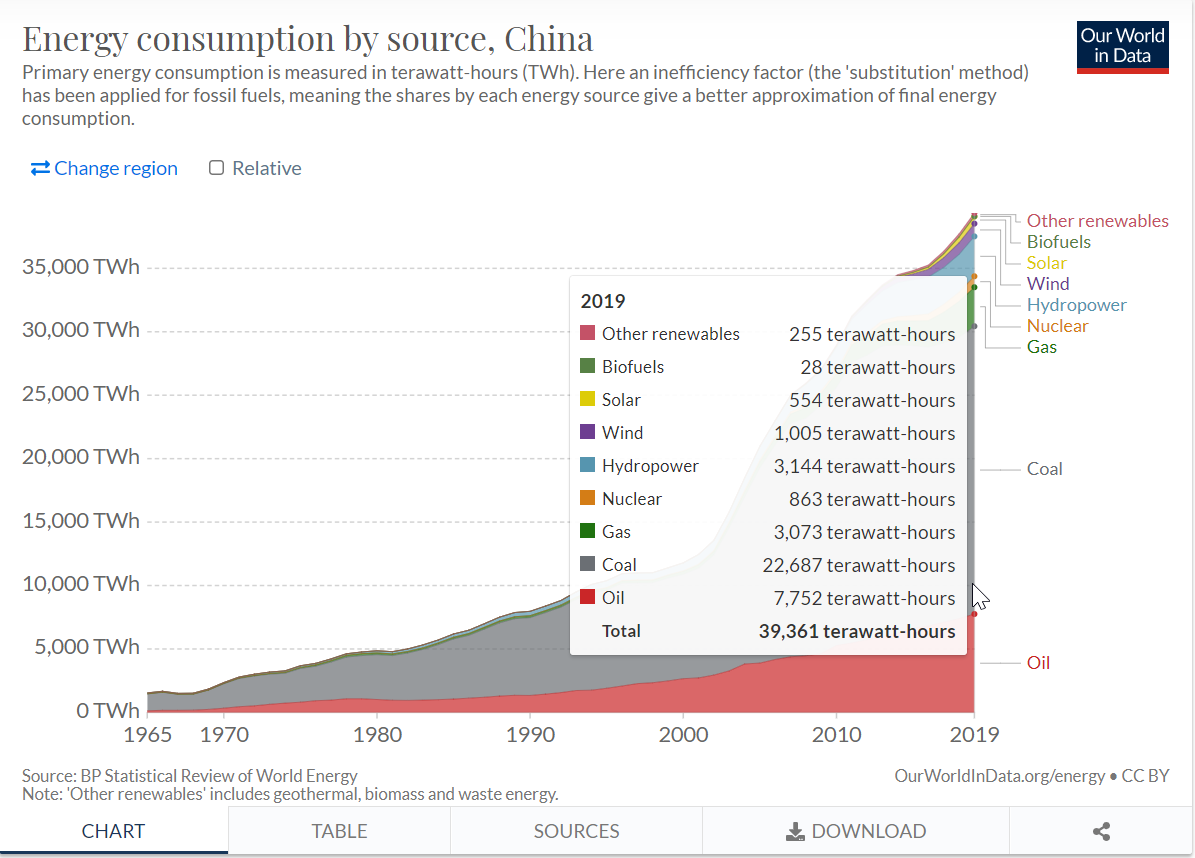


COMMENTS